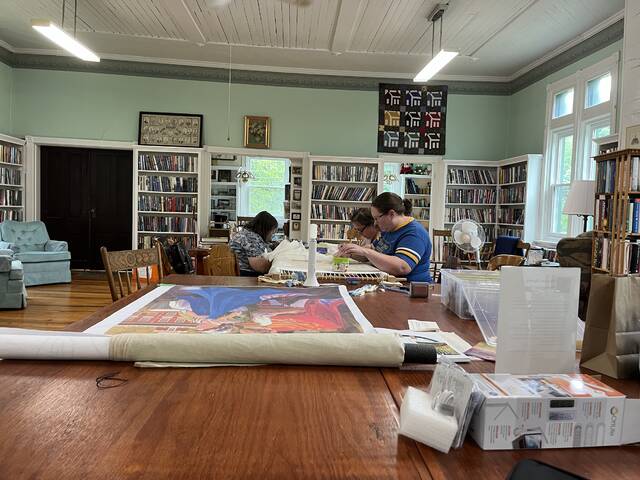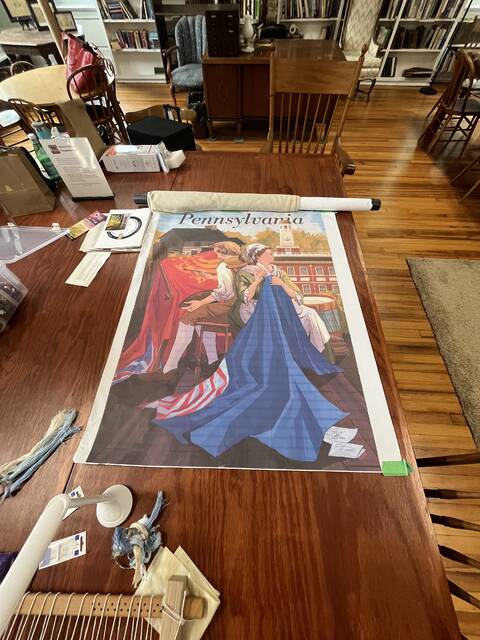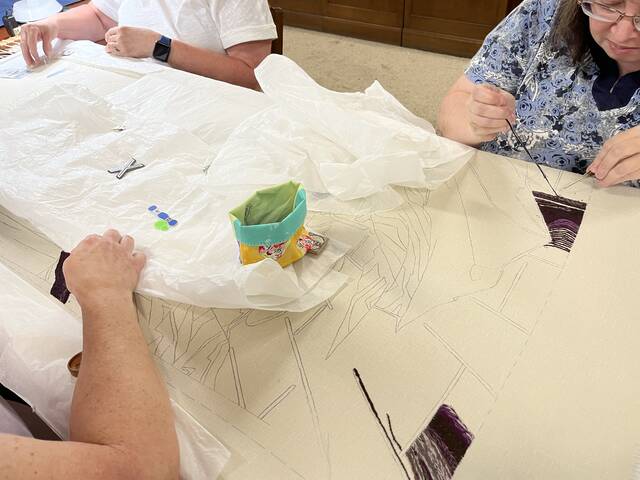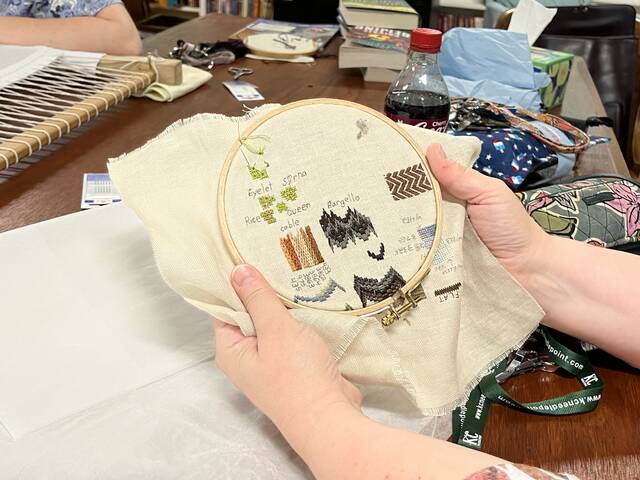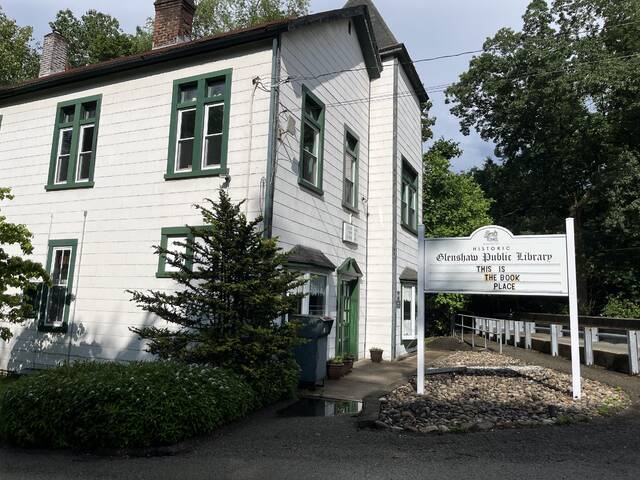Embroiderers at Glenshaw Public Library document Pa.'s history for 'America's Tapestry' project
Local embroiderers are spending their Thursday evenings for the next year at the Glenshaw Public Library, stitching the Pennsylvania panel for the “America’s Tapestry” exhibition, which is scheduled to be completed in time for the 250th anniversary of the Declaration of Independence’s signing.
Raven Fagelson, state co-director of the Pennsylvania panel’s production, said the tapestry will be made up of 13 embroidered 35-by-45-inch panels, one for each of the original 13 colonies, depicting “stories and events from the American Revolution that are not as well known.”
“We have a lot of pictures of Washington crossing the Delaware, but we don’t have as many pictures of the Birch Trials up in New York, which is on the New York panel,” said Fagelson, who lives in Pittsburgh’s Brighton Heights neighborhood.
“Another story, and the one that features on the Pennsylvania panel, is that of Rebecca Young.”
Though Betsy Ross is famous for her role as a Revolutionary War flag maker, even earlier historical records document Rebecca Young of Philadelphia making a battle standard for the Pennsylvania Navy, as she can be seen doing in the Pennsylvania panel’s design.
“She also created blankets and sewed drum covers as well, so if you look at the Pennsylvania panel, you will see a drum and blankets there,” Fagelson said.
“In addition, we have an unknown man painting a rattlesnake flag. That particular rattlesnake flag is currently at home in the Fort Pitt Museum. It is the last remaining rattlesnake flag from the Revolutionary War,” Fagelson said, referring to the flag originally created for Col. John Proctor’s 1st Battalion of Westmoreland County, now more commonly known as the “Don’t Tread on Me” flag.
The Pennsylvania panel is a collaboration between Stefan Romero, historical partner Seton Hill University, state co-directors Fagelson and Mary Van Tyne, the Three Rivers Chapter of the Embroiderers’ Guild of America and Maggie Weng, an illustrator from the Philadelphia area.
The idea for the tapestry was first conceived by Romero, a costume designer and alumnus of Carnegie Mellon University and the University of Glasgow, after he visited the “Great Tapestry of Scotland,” according to Fagelson and the “America’s Tapestry” website.
Though Three Rivers Chapter members will be spearheading the panel’s progress, they welcome anyone to come to the library and help stitch during their regular time slot — from 5:30 to 9 p.m. every Thursday until May 2026.
“Everyone is welcome to come for as little or as much time as they would like,” said Van Tyne, a resident of Pittsburgh’s Larimer neighborhood.
“It’s not going to stitch itself.”
According to Van Tyne, it was “quite a trial” to find the right location for the panel’s production — they needed to find a location that has good lighting, is accessible for all the embroiderers, has space to store the large panel and its frame, has parking spots and has an easily accessible sink where the embroiderers can wash their hands before handling the panel, to keep it as clean as possible.
The embroiderers found all of that and more at the Glenshaw Public Library, which, having been founded in 1895, is one of the oldest free libraries in the region, according to their website.
“As soon as we walked in, we thought, ‘This is perfect,’ ” Van Tyne said.
“They have fantastic historic provenance here in Glenshaw, and it’s just a wonderful partnership that we’re really excited about.”
Librarian Sandy Russell said she and the rest of the library’s board of directors are just as excited about the partnership.
“We’re honored to have them here at the library, and we’re so excited to be a part of this,” Russell said.
“We’re looking for ways to include the community, bring the community in and highlight another event that we’re having here, all in the name of history.”
Fitting with the historical theme of the tapestry project, the Glenshaw Public Library leans into the “old-fashioned” style.
“In the history room, I have a lot of very old books that I maintained because I wanted the feel of the library not to change,” Russell said.
“When you check out a book, it’s the old-fashioned way of stamping the book with a rubber stamp and the date and writing in your card number. We don’t scan anything.”
The Pennsylvania panel will occasionally travel, “in the spirit of getting as many Pennsylvanians to work on it as possible,” Fagelson said.
So far, the panel already has traveled to an Embroiderers’ Guild of America Mid-Atlantic region conference in Gettysburg, and later this year it will travel to Valley Forge.
“I’m hoping to take this to every corner of the state, provided that I can find people interested,” Fagelson said.
Those interested in following the Pennsylvania panel’s progress can check out @americastapestry.pa on Instagram.
Bella Markovitz is a TribLive contributing writer.
Remove the ads from your TribLIVE reading experience but still support the journalists who create the content with TribLIVE Ad-Free.

